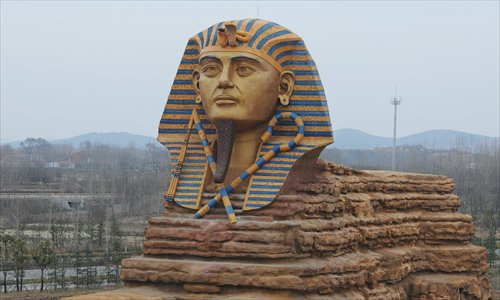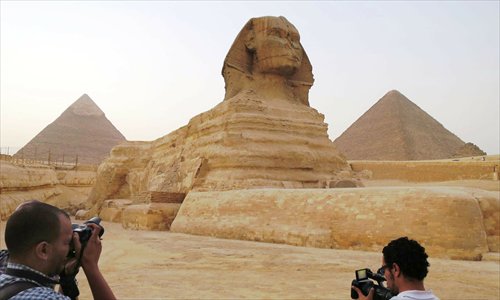HOME >> LIFE
Creative desert
By Lu Qianwen Source:Global Times Published: 2015-3-8 20:03:01
Another copy of a famous landmark makes waves in China

Replica sphinx in Chuzhou, Anhui Province. Photo: CFP

The Great Sphinx of Giza in Egypt Photo: IC
As the country attempts to re-brand its products as "created in China" instead of "made in China," efforts to combat counterfeits and protect intellectual property rights have been stepped up. This is especially true of the last two years, as combating counterfeits has been elevated to a level that is closely related to the country's overall economic transformation and sustainability.
However, it seems that in response China's counterfeits have also begun putting on newer and fancier masks. From a past dead set on imitating mass-produced industrial goods, an increasing amount of counterfeits are now appearing in the creative industry.
The latest case is a new copy of Egypt's sphinx that has been built in Chuzhou, Anhui Province - not long after the highly controversial sphinx replica that appeared last year in Shijiazhuang, Hebei Province.
One after another
Located at an under construction animation production park in Chuzhou, the copycat sphinx is a 1 to 1 recreation of the Great Sphinx of Giza in Egypt, except for the color of the monument's head and the two extra horns on its forehead.
Making a big splash since photos were released online last Wednesday, the park's deputy general manager explained to media that the sphinx is one of the scenic spots for the park, which in addition to being a home for animation studios will also incorporate tourism by opening the park to visitors and providing games and entertainment.
Last year, a complete replica of the Great Sphinx of Giza built in Shijiazhuang, near Beijing made waves after the Egyptian government complained to UNESCO. Explaining that the sphinx was meant to be a temporary site for shooting films and TV series, the production company that built the replica soon had it dismantled.
Although no official protests have been made yet and the media fallout hasn't been as overwhelming as that of the Shijiazhuang sphinx last year, what seems to have people concerned the most is that in addition to the sphinx, the steel frame of a pyramid can be seen under construction at the Chuzhou park and more replicas of other landmarks are also underway.
Replicas of famous international landmarks are fairly common in China. There used to be a replica of France's Chapel of Notre Dame du Haut in Zhengzhou, Henan Province during the 1990s, but it was later demolished after a protest by the Le Corbusier fund. Meanwhile, Britain's Tower Bridge can also be "visited" in China, since the city of Suzhou in Jiangsu Province built a replica of London's well-known landmark in 2012. It has become extremely popular among tourists.
Benefiting no one
Not all of these replicas have caused a negative stir. After a replica of the Austrian village of Hallstatt was built in Huizhou, Guangdong Province, in 2012, the then head of the Consulate General of the Republic of Austria in Guangzhou expressed his support for the project as he felt it honored the existence of the original Austrian village located all the way on the other end of the Globe. The recreated village in Huizhou has also become a local hot spot.
However, in my opinion, no matter if these fake landmarks are met with protest or support, they do nothing to benefit the original heritage or showcase the creativity of the builders of these copycats. Sure, over the short term these pseudo landmarks may provide people with a chance to learn more about a place they may never have the chance to see in real life, but over the long run, they end up doing more harm to the original cultural heritage since some people may not bother visiting the real landmark since they already satisfied their curiosity with the copycat version.
Meanwhile, the creativity of a country that allows these fake heritages to appear one after another is sure to suffer as companies end up turning a profit on these non-original works and inspire even more people to make more blatant rip-offs. They are also especially damaging to China's creative spirit considering the government's recent stress on creativity stimulated growth.
Government oversight
While the replica in Shijiazhuang caused a huge uproar in the media and among the public last year, missing was the voice of relevant government institutions. Although media controversies surrounding these "creative" counterfeits raise public concerns, they do little to affect the profits of the companies that keep building these fakes and have no legal authority. The latter reason being one of the main reasons that these copycats keep popping up all over the country despite public criticism.
With the economic progress the country has gone through over the past five years, the government can no longer turn a blind eye to these counterfeits in the cultural industry. Relevant regulations need to be established to put a lid on this copycat behavior before it spins totally out of control. In the end, this is not just about creating a fun and entertaining atmosphere, but rather about nurturing an environment in China that encourages and rewards creativity.
Posted in: Miscellany